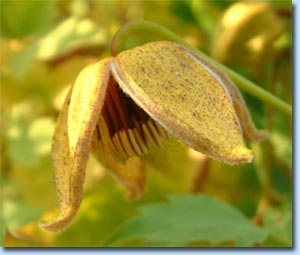 This
is a delightful but very vigorous cultivar produced
from a cross of C. ladakhiana and C. tibetana subsp. vernayi var. laciniifolia. This
is a delightful but very vigorous cultivar produced
from a cross of C. ladakhiana and C. tibetana subsp. vernayi var. laciniifolia.
The flowers are nodding to semi-nodding bell shaped and are usually produced
from the upper leaf axils of new growth. The 4 thick sepals are a yellow although
this can vary from greenish-yellow to a golden-yellow. The main colour is overlaid
with many red or purple spots as though someone has flicked a paint brush at
it.
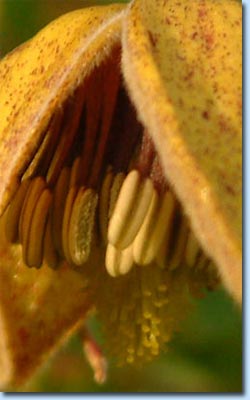 The
inner sepal colour is similar to outer although it is slightly
hairy or downy and this characteristic extends to the margins or
edges. The
inner sepal colour is similar to outer although it is slightly
hairy or downy and this characteristic extends to the margins or
edges.
The sepals are elliptic to lanceolate in shape and are finished with a recurving
pointed tip. The sepals open as the flower ages making the flowers up to 4 or
5 cm across
The reproductive organs are made up of maroon to brown filaments and 'off' yellow
anthers while the stigma is a greenish-yellow.
This late flowering plant is a member of the pruning group 3 (hard prune) variety
and generally reaches a height of 12' (360 cm) although it can go a lot higher
depending on local conditions and planting position.
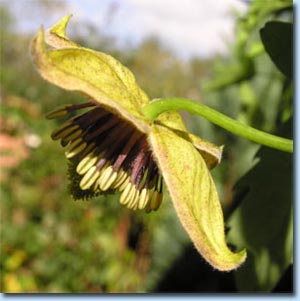 It
is a very vigorous grower and needs a bit of space to grow especially
if it is given some sharp drainage which is what it likes although
its vigour seems to enable it to almost grow anywhere just as long
as the roots aren't sitting in water. It
is a very vigorous grower and needs a bit of space to grow especially
if it is given some sharp drainage which is what it likes although
its vigour seems to enable it to almost grow anywhere just as long
as the roots aren't sitting in water.
It can be placed in any aspect although the more sun you give it the earlier
it will flower. If placed on a north wall you may not get flowers until September
whereas if given sun they will appear in August.
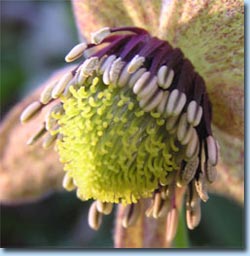
It produces enormous tuberous roots which it needs to sustain the amount of growth
this plant can put on in one year even on a north facing wall.
The first two photos on this page show a plant supplied to me under the name
of C. ladakhiana which obviously it isn't. The later photographs are
of a plant I bought under the correct name which shows basically the same characteristics
although the sepals open much wider as does the central boss of staminodes.
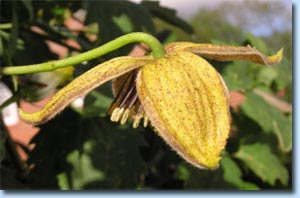 Occasionally
it sports flowers with what seem like smaller inner sepals although
these are a generally half the length and width of the main sepals
(see 2nd to last picture to get some idea). Occasionally
it sports flowers with what seem like smaller inner sepals although
these are a generally half the length and width of the main sepals
(see 2nd to last picture to get some idea).
On a flower to plant size ratio it does not seem to pull its weight in the garden
and should be kept as a large space filler or as a collectors plant.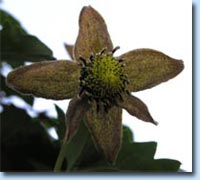
It will swamp everything within a radius of about eight feet either
side of its planted position so make sure your trellis is strong
- you have been warned!. Just as an aside my initial purchase of
this cultivar which was labeled C.ladakhiana was
planted in a container (which is not unheard of for this second plant).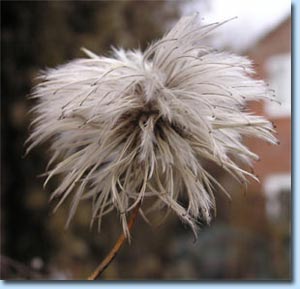
After its first year in which I realised something was not right
as it was definately not the plant I bought I decided to leave it
and remove it from its pot the following year. When the time came
the plant had taken root through the drain holes and into the tarmac
underneath!
| Flower
Colour |
- |
Inner
and outer Sepals colour is usually yellow
but can be green-yellow or golden-yellow
and all are speckled with red or purple. |
| Pruning
Group |
- |
Group
3 |
| Hardiness |
- |
Zone
4 |
| Height |
- |
10-12'+
or 300-360+ cm |
| Flowering
Season |
- |
Late
July to September |
| Aspect |
- |
Any
aspect - but flowers earlier in a sunny
site. |
| Fragrant |
- |
No |
| Evergreen |
- |
No |
| Other
info |
- |
Raised
from a cross of C. ladakhiana and
C. tibetana subsp. vernayi var. laciniifolia. |
|









